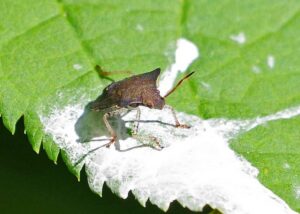Note: All links leave to external sites.
Howdy, Bug Fans,
The BugLady thinks stink bugs are cool, and she loves finding species she hasn’t seen before. This year, she saw two new ones – the first one in a sand dune, and the second in a bog – but she suspects that habitat is secondary in the stink bugs’ game plan to the availability of food.
They’re called “stink bugs” because they have glands in the thorax that produce, as Eric Eaton says in the Field Guide to Insects of North America, “volatile aromatic compounds sure to repel all but the most desperate predators.” One author adds that “Stink bugs can smell pretty bad. Even my hens turn up their beaks when one crawls by….”
Some stink bugs are predaceous, but most are plant-eaters, and many, including today’s pair, aren’t picky about the plant species they feed on. They are “true bugs” in the order Hemiptera (Hemiptera means “half-wing,” which refers to wings that are leathery at the near end and membranous at the far end), and they’re in the family Pentatomidae.
Like other Hemipterans, they feed by puncturing their food with their piercing-sucking mouthparts, injecting enzymes that soften the tissues, and then sucking out the contents. If they’re feeding on, say, a peach, the puncture may inadvertently inoculate the immediate area with bacteria, causing rot, and soft fruits develop “dimples” called cat-facing, both of which make the fruit less attractive in your grocery store.
Both of today’s species are divided up into several subspecies, and the BugLady was surprised to see that there were differences within each species not only in color, but also in the spiny-ness of their “shoulders,” depending on their geography and even season.
 RED-SHOULDERED STINK BUGS (Thyanta custator) occur across North America from Canada to Guatemala, and from sea to shining sea; the BugLady found this lovely, pastel stink bug in the dunes. There are three subspecies, the most common of which is Thyanta custator accera.
RED-SHOULDERED STINK BUGS (Thyanta custator) occur across North America from Canada to Guatemala, and from sea to shining sea; the BugLady found this lovely, pastel stink bug in the dunes. There are three subspecies, the most common of which is Thyanta custator accera.
At about ½” long, Red-shouldered stink bugs (Thyanta custator) are fairly large, as stink bugs go. They come in varying shades of green and tan, and the red on their shoulders can be very conspicuous or absent, https://bugguide.net/node/view/1035753/bgimage, https://bugguide.net/node/view/401270/bgimage.
Young stink bugs (nymphs) are often much more colorful than their elders, https://bugguide.net/node/view/768528/bgimage.
Females lay clusters of barrel-shaped eggs on the leaves and stems of plants, and the nymphs feed on young leaves, buds, flowers, and developing seeds of their natal plants. When they mature (in about a month) and have functional wings, they spread out to neighboring plants. The RSSB has been found on many species of plants in more than a dozen plant families, some of them agricultural crops like wheat, beans, alfalfa, some fruits, and hemp, but they’re not on USDA Wanted Posters because they mainly damage seed production.
They overwinter as adults in leaf litter, but like other stink bugs, they will happily spend the colder months in a warm house. In spring, they awake and spread out to find vegetation – and other RSSBs.
 The second species was the nymph of (probably) a DUSKY STINK BUG (Euschistus tristigmus luridus). Of the two forms/subspecies in North America, Euschistus tristigmus luridus) occurs the farthest north. The subspecies that’s found in the South and into Central America, Euschistus tristigmus tristigmus, is smaller, and the front edges of its thorax are pointier. Dusky stink bugs are found in grasslands, woodlands, and riparian edges (and, apparently, bogs).
The second species was the nymph of (probably) a DUSKY STINK BUG (Euschistus tristigmus luridus). Of the two forms/subspecies in North America, Euschistus tristigmus luridus) occurs the farthest north. The subspecies that’s found in the South and into Central America, Euschistus tristigmus tristigmus, is smaller, and the front edges of its thorax are pointier. Dusky stink bugs are found in grasslands, woodlands, and riparian edges (and, apparently, bogs).
Quick Euschistus tristigmus luridus Dictionary Side Trip: Five hundred years ago, “lurid” meant “pale (so pale that you glow in the darkness), sickly, the color of bruises, ghastly, or yellowish.” By the 1700s, its meaning was shifting and the word was used to describe the faint red glow of a fire shrouded by smoke. In about 1850, its meaning changed again, to something like today’s common usage – “sensational, shocking, horrifying, or bright, intense, and vivid.”
Here are the three spots suggested by “tristigmus,” though not all individuals have them.
The broad strokes of the Dusky stink bug’s natural history are similar to those of the RSSB, with adults overwintering and laying eggs as vegetation starts growing in spring. It uses a different set of food plants than the RSSB, including some wildflowers like clover, goldenrod, and Black-eyed Susan, some ash and oak species, fruits like blackberries and red delicious apples, and some field crops (and bugguide.net says that it is “occasionally predaceous”).The BugLady sees nymphs of other bugs, like leaf-footed bugs, near bird droppings; they get minerals from them, and she wonders if stink bugs do, too. Like the RSSB, it has little to no economic impact (and it sure is cute).
 The BugLady gives thanks for dragonflies (and she would like to know where the mosquito that she photographed in her house on November 11 has been for the past month).
The BugLady gives thanks for dragonflies (and she would like to know where the mosquito that she photographed in her house on November 11 has been for the past month).
The BugLady
